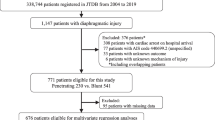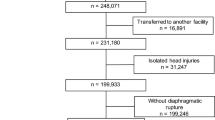Abstract
Objective
We investigated our 12-year experience of traumatic diaphragmatic injury (TDI) in our emergency medical center. This study aimed to clarify clinical features of TDI and identify factors affecting mortality and morbidity in TDI treatment.
Methods
We analyzed clinical characteristics, Injury Severity Score (ISS), probability of survival (Ps), and mortality of patients treated for TDI at the Tertiary Emergency Medical Center of Tokyo Metropolitan Bokutoh Hospital between January 1999 and December 2010.
Results
TDI occurred in 28 patients. Of 21 TDI patients (75 %) who underwent surgery, 2 died (operative mortality, 9.5 %). Seven (25 %) presented with cardiopulmonary arrest, and TDI was detected during thoracotomy in the emergency room; all of these patients died. Blunt TDI occurred in 12 patients; penetrating TDI in 16. Blunt trauma patients had significantly more injured organs (3.75 ± 0.28, P = 0.043), higher ISS (P = 0.024), and lower Ps (P = 0.048). Lengths of intensive care unit (ICU) stay and hospital stay were greater in blunt cases than in penetrating cases (P = 0.004 and P = 0.02, respectively). Non-survivors had significantly higher ISS (P < 0.001), lower Ps (P = 0.0025), and larger injured diaphragm size (8.44 ± 1.97, P = 0.048). In blunt cases, delays in diagnosis and repair of TDI led to significantly increased ICU stay (16.25 ± 3.64, P = 0.017).
Conclusion
TDI occurs in cases of multiple trauma. Higher ISS and lower Ps predict death; therefore, prompt diagnosis of TDI and immediate repair of diaphragmatic injury are important.

Similar content being viewed by others
Explore related subjects
Discover the latest articles and news from researchers in related subjects, suggested using machine learning.References
Meyers BF, McCabe CJ. Traumatic diaphragmatic hernia. Occult marker of serious injury. Ann Surg. 1993;218:783–90.
Beauchamp G, Khalfallah A, Girard R, Dube S, Laurendeau F, Legros G. Blunt diaphragmatic rupture. Am J Surg. 1984;148:292–5.
Kole KL. Traumatic diaphragmatic injuries. Trauma Q. 2002;15:109–20.
Arsensio JA, Demetriades D, Rodriguez A. Injury to the diaphragm. In: Mattox KL, Feliciano DV, Moore EE, editors. Trauma. 4th ed. New York: McGraw-Hill; 2000. p. 603–32.
Rosati C. Acute traumatic injury of the diaphragm. Chest Surg Clin N Am. 1998;8:371–9.
Kearney PA, Rouhana SW, Burney RE. Blunt rupture of the diaphragm: mechanism, diagnosis, and treatment. Ann Emerg Med. 1989;18:1326–30.
Grage TB, Maclean LD, Campbell GS. Traumatic rupture of the diaphragm: a report of 26 cases. Surgery. 1959;46:669–81.
Estrera AS, Platt MR, Mills LJ. Traumatic injuries of the diaphragm. Chest. 1979;75:306–13.
Degiannis E, Levy RD, Sofianos C, Potokar T, Florizoone MG, Saadia R. Diaphragmatic herniation after penetrating trauma. Br J Surg. 1996;83:88–91.
Brasel KJ, Borgstrom DC, Meyer P, Weigelt JA. Predictors of outcome in blunt diaphragm rupture. J Trauma. 1996;41:484–7.
Dirican A, Yilmaz M, Unal B, Piskin T, Ersan V, Yilmaz S. Acute traumatic diaphragmatic ruptures: a retrospective study of 48 cases. Surg Today. 2011;41:1352–6.
Baker SP, O’Neill B, Haddon W Jr, Long WB. The injury severity score: a method for describing patients with multiple injuries and evaluating emergency care. J Trauma. 1974;14:187–96.
Champion HR, Sacco WJ, Copes WS, Gann DS, Gennarelli TA, Flanagan ME. A revision of the Trauma Score. J Trauma. 1989;29:623–9.
Boyd CR, Tolson MA, Copes WS. Evaluating trauma care: the TRISS method. Trauma Score and the Injury Severity Score. J Trauma. 1987;27:370–8.
Kawaguchi H, Kawahara K. Study regarding accessibility to emergency medical care centers: results from the GIS simulation. J Jpn Soc Hosp Admin. 2006;43:35–46.
Cho Y, Hishiyama H, Ikeda J, Nakamura Y, Suzuoki M, Shibano N. A study of traumatic rupture of the diaphragm. J Jpn Surgical Assoc. 2001;62:924–8.
Ozgüç H, Akköse S, Sen G, Bulut M, Kaya E. Factors affecting mortality and morbidity after traumatic diaphragmatic injury. Surg Today. 2007;37:1042–6.
Hanna WC, Ferri LE, Fata P, Razek T, Mulder DS. The current status of traumatic diaphragmatic injury: lessons learned from 105 patients over 13 years. Ann Thorac Surg. 2008;85:1044–8.
Lewis JD, Starnes SL, Pandalai PK, Huffman LC, Bulcao CF, Pritts TA. Traumatic diaphragmatic injury: experience from a level I trauma center. Surgery. 2009;146:578–83.
Tiberio GA, Portolani N, Coniglio A, Baiocchi GL, Vettoretto N, Giulini SM. Traumatic lesions of the diaphragm. Our experience in 33 cases and review of the literature. Acta Chir Belg. 2005;105:82–8.
Johnson CD. Blunt injuries of the diaphragm. Br J Surg. 1988;75:226–30.
Maddox PR, Mansel RE, Butchart EG. Traumatic rupture of the diaphragm: a difficult diagnosis. Injury. 1991;22:299–302.
Boulanger BR, Kearney PA, Tsuei B, Ochoa JB. The routine use of sonography in penetrating torso injury is beneficial. J Trauma. 2001;51:320–5.
Broos PL, Rommens PM, Carlier H, Van Leeuwen JE, Somville FJ, Gruwez JA. Traumatic rupture of the diaphragm. Review of 62 successive cases. Int Surg. 1989;74:88–92.
Cayten CG, Stahl WM, Agarwal N, Murphy JG. Analyses of preventable deaths by mechanism of injury among 13,500 trauma admissions. Ann Surg. 1991;214:510–20.
Feliciano DV, Cruse PA, Mattox KL, Bitondo CG, Burch JM, Noon GP. Delayed diagnosis of injuries to the diaphragm after penetrating wounds. J Trauma. 1988;28:1135–44.
Author information
Authors and Affiliations
Corresponding author
Rights and permissions
About this article
Cite this article
Okada, M., Adachi, H., Kamesaki, M. et al. Traumatic diaphragmatic injury: experience from a tertiary emergency medical center. Gen Thorac Cardiovasc Surg 60, 649–654 (2012). https://doi.org/10.1007/s11748-012-0132-1
Received:
Accepted:
Published:
Issue Date:
DOI: https://doi.org/10.1007/s11748-012-0132-1




